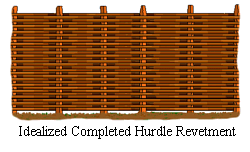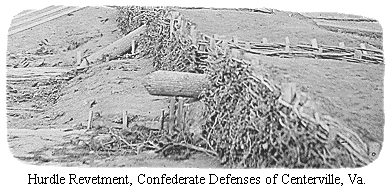A hurdle revetment was a sort of woven wall composed
of flexible branch rods randed around picket poles driven at short intervals
along the foot of an interior slope. Hurdles may have been one of two or
three most common methods used to form revetments for interior slopes during
the Civil War. A hurdle revetment could be thrown up relatively rapidly,
according to some manuals, plus material was usually plentiful and light
enough to be hauled about on soldiers' backs without much trouble. This type
of revetment required little specialized knowledge and no unfamiliar tools
to construct. Hurdles also had the advantage of requiring absolutely no
extraneous digging or prior preparation (except for selection and collection
of materials) such as planting posts or half-burying fascines.
 As
soon as working parties brought the rising parapet up to the level of the
banquette tread picket poles were driven 8 to 10 inches apart along the line
of the foot of the interior crest. These poles were between 70 and 75 inches
long and 1 1/2 inches in diameter. They were driven into the parapet to a
depth of between 18 and 24 inches and at an angle that followed the intended
angle of the interior slope. Once working parties performing this task had
driven enough poles, other working parties started randing small flexible
tree branches or strong vines (called rods) around the poles. Randing, as
explained in the Detailed Note On Gabions, was the simplest form of weaving
rods onto poles: the end of a rod was placed behind one of the poles, was
then run behind the next pole, and run in front of the next pole, and so
on until the rod did not reach all the way to the next pole in line. The
rod was then pounded down firmly against the next rod down, the end bent,
and then inserted into the soil of the rising interior slope. Soil was packed
in behind the rods to form the As
soon as working parties brought the rising parapet up to the level of the
banquette tread picket poles were driven 8 to 10 inches apart along the line
of the foot of the interior crest. These poles were between 70 and 75 inches
long and 1 1/2 inches in diameter. They were driven into the parapet to a
depth of between 18 and 24 inches and at an angle that followed the intended
angle of the interior slope. Once working parties performing this task had
driven enough poles, other working parties started randing small flexible
tree branches or strong vines (called rods) around the poles. Randing, as
explained in the Detailed Note On Gabions, was the simplest form of weaving
rods onto poles: the end of a rod was placed behind one of the poles, was
then run behind the next pole, and run in front of the next pole, and so
on until the rod did not reach all the way to the next pole in line. The
rod was then pounded down firmly against the next rod down, the end bent,
and then inserted into the soil of the rising interior slope. Soil was packed
in behind the rods to form the
 parapet as
soon as they presented a sufficiently solid surface to retain the dirt. This
procedure was repeated, rod by rod, until the revetment reached the height
of the interior crest. parapet as
soon as they presented a sufficiently solid surface to retain the dirt. This
procedure was repeated, rod by rod, until the revetment reached the height
of the interior crest.
 This
type of revetment required more labor for its actual construction than most
other types of revetments simply because the material was smaller and required
more handling. As photographs of hurdle revetments show, a very large number
of well pounded rods were required to produce a surface capable of retaining
soil. This is balanced by the availability of material; branches that would
otherwise be used as kindling in campfires or simply wasted could be used
as rods. Again due to the small size of the rods hurdles tended to rot at
a faster rate than revetments made up of larger members; once the poles
deteriorated and started giving way the revetment failed. Hurdles were good
for an easy revetment job that would not have to last very long, but were
not suitable for field works that would be used for a prolonged period of
time. This
type of revetment required more labor for its actual construction than most
other types of revetments simply because the material was smaller and required
more handling. As photographs of hurdle revetments show, a very large number
of well pounded rods were required to produce a surface capable of retaining
soil. This is balanced by the availability of material; branches that would
otherwise be used as kindling in campfires or simply wasted could be used
as rods. Again due to the small size of the rods hurdles tended to rot at
a faster rate than revetments made up of larger members; once the poles
deteriorated and started giving way the revetment failed. Hurdles were good
for an easy revetment job that would not have to last very long, but were
not suitable for field works that would be used for a prolonged period of
time.

[This page originally appeared as a Detailed Note Page on
the old Civil War Field Fortification Website.] |